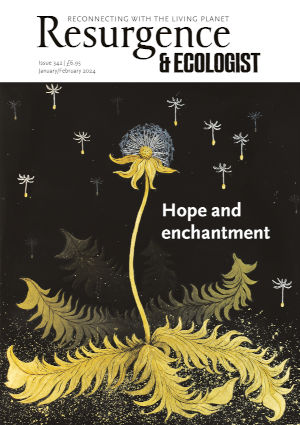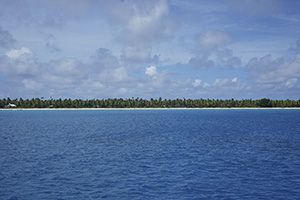Can you introduce yourself?
My name is Kathy Jetñil-Kijiner and I am a poet as well as climate envoy for the Marshall Island government’s ministry of environment. I also run Jo-Jikum, a non-profit based in the Marshall Islands, working with youth and environmental issues. The ‘Our Life is Here’ expedition was five years in planning – Covid interrupted. Having with us the voice of the Jo-Jikum youth team, the Marshallese elders, a traditional weave artist and a master navigator was central to our planning, as was visiting the atoll community on Wotho. The expedition was about our engagement with these sites of historical trauma, but it was also an educational opportunity to expose international artists to Marshallese culture, history and resilience.
Tell us about the personal impact COP21 had on you
COP21 (Conference of the Parties) in Paris in 2016 was a massive event for me. It was my first COP and the 21st year in which it had taken place. It was also a significant milestone for the Republic of the Marshall Islands.
At the time, I remember, the big issue was to limit global warming to an increase of 1.5 C in order just to stay alive. We needed to keep the global temperature rise under 1.5 for islands like the Marshall Islands to stay afloat; to stay above water. During the conference I went to climate meetings with a lot of folks who had much more experience with COPs and with the UNFCCC process, who told me straight out, there’s no way we can get the world to limit the warming to 1.5. I remember at the time digesting this information as someone from the Marshalls – being told you can’t get the limit of 1.5 agreed internationally, and yet knowing that 1.5 is supposed to be our safety level. They were basically condemning us.
Our late minister of foreign affairs Tony de Brum* was leading at the highest level, and people say that it was at COP21 that he ‘grandfathered’ the Paris Treaty – so it was because of him that we got 1.5. Somehow he was able to negotiate and get these other, larger countries to join the coalition, which was the called the High Ambition Coalition, and to come together and agree to the 1.5 threshold. And so we got 1.5 in the Paris Treaty. And it was massive.
I think that really indicated to me that the Republic of the Marshall Islands can achieve far more than would be expected given its size, that it is actually possible to represent our country at these international conventions as a vulnerable nation and to push people to hold themselves to a higher standard. I’m so grateful for Tony that he took charge in this way, and his legacy leaves us with this pathway, which means we can still engage at the international level. The Marshall Islands’ average height above sea level is only about two metres, and we contribute 0.0007% of the world’s global emissions. We could become the most solarised country in the world, and we’d still be under water.
Tell us more about COP. What is it like to attend these climate meetings as a Marshall Islander?
The power imbalances are massive. Colonialism is still very much a part of the climate conversation; racism, ableism, all of it is still there. To be an islander, to be a young brown woman in those spaces, it can be really scary – and so every time we attend COP, every year, it is a battle.
I do see that a lot of the work I’ve been doing is being a bridge – bridging between the government and the NGOs, bridging between youth and the adults, bridging between community members and the government, and then of course between international folks and my Marshallese community. The nice thing about being a poet and doing artwork is I don’t have to bridge. It’s just me. I love art and I love being able to play. I think for me poetry and art is play. And I think you really need that kind of thinking in our world of climate crisis. You need to find avenues of joy.
Tell us about your artist work with ‘Our Life is Here’. What are you working on?
The ‘Our Life is Here’ expedition with Cape Farewell gifted me the time to be with other creatives and explore ideas and narratives. I’m playing with a character from one of our Marshallese legends – a woman demon called the Mejenkwaad who is known to eat babies. She has shark teeth in the back of her head, can swallow whole canoes, etc. She is just really bloodthirsty and full of rage. It’s pretty dark stuff. I did some research into the legend and talked to family members who grew up with this legend as a sort of bogeyman – a monster you were meant to avoid or that preyed on women. But some women also theorised to me that it may have been a way to explain post-partum depression for Marshallese women. Some believe that this is why we prioritise these women to have company at all times after giving birth – for their mental health.
I began exploring this character about three years ago while writing about the effects of the nuclear legacy on Marshallese women’s bodies. Due to the radioactive poisoning from the nuclear fallout, a number of these women experienced miscarriages and had babies with birth defects. Some of these birth defects were described by Marshallese women as ‘jellyfish babies’. I read an interview with some women who had given birth to such babies, and they said they felt like a monster – because the belief is that if a woman has a baby with a birth defect, she must have done something wrong. There was no communication from the US government about these effects, or how they could be linked to the nuclear testing. And these women, they had to just bury their miscarriages alone and in silence, and it is so heart-breaking to imagine them doing that, not knowing it wasn’t their fault.
My personal experience with postpartum, connected to these women’s horrific experience of the ‘jellyfish’ babies and miscarriages, has led me towards embody-ing the Mejenkwaad – a demon that so many women are terrified of.
The expedition allowed me time to play with performance and persona, and the truth is, I have a lot of love for this character. She is just completely consumed by rage. And I feel a lot of women are silenced. We’re told not to be angry. We’re told to be pretty and quiet and whatever, and she just gets to be so straightforward and inhale everything. But I think with issues like the nuclear legacy, the climate crisis, the disempowerment of women, we have every right to be angry. And I think that’s why I like to embody her.
* Tony de Brum's granddaughter Kalena de Brum, was on the Cape Farewell expedition, working as a marine scientist.
The expedition: This was UK artist David Buckland, Marshall Islander poet Kathy Jetn̄il-Kijiner and American artist Michael Light’s ninth expedition to the heart of the Anthropocene, the Republic of the Marshall Islands, offering first-hand experience of climate change displacement and massive nuclear destruction. Sailing aboard MV Pacific Master and MV Surveyor, a powerful team of 30 international, Oceanian and Marshallese artists, writers, scientists and filmmakers witnessed this crucial example of our human-altered world. www.ourlifeishere.org








